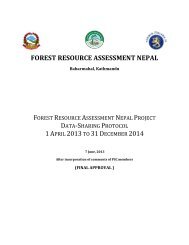Download - FRA Nepal
Download - FRA Nepal
Download - FRA Nepal
Create successful ePaper yourself
Turn your PDF publications into a flip-book with our unique Google optimized e-Paper software.
7.2 Component 1: Forest Resource Assessment<br />
7.2.1 Assessment of information and data needs<br />
7.2.1.1 Scale of <strong>FRA</strong> and hierarchy of data needs<br />
Forest data are needed at different levels and scales for different objectives and use. On the basis of coverage and scale <strong>FRA</strong><br />
is carried out at global, national, sub-national and forest management levels. Moreover, sustainable natural resource<br />
management is a hierarchical process starting from policy level (Forest Policy, National Forest Program, Master Plan) and<br />
ending with forest management at operation level. However, this project has been designed to conduct NFI, which will<br />
follow the national level <strong>FRA</strong> approach. The concept of hierarchy of data needs and requirements of <strong>FRA</strong> is presented in<br />
Table 2.<br />
Table 2. Hierarchy of Data Needs<br />
Decisionmaking<br />
Objectives Quality/type of data Requirements of <strong>FRA</strong><br />
level<br />
1. National level policy making land-use, ownership / management 2 or 3 -phase sampling –<br />
strategic planning regime<br />
low/high resolution<br />
land-use planning type of vegetation<br />
remote sensing material<br />
ecosystem service potential<br />
+ statistically sound<br />
mean values of volumes, field sampling<br />
diameters, etc. over large areas<br />
(whole country)<br />
2. Intermediate<br />
level<br />
3. Operational<br />
level: CFUG,<br />
government<br />
managed<br />
forest, etc.<br />
strategic planning<br />
land-use planning<br />
strategic planning of<br />
government<br />
managed forests<br />
sustainable use of<br />
natural resources<br />
land-use, ownership amended with<br />
cadastral and/or socio-cultural data<br />
type of vegetation<br />
ecosystem service potential<br />
mean values of volumes,<br />
diameters, etc. over region’s forest<br />
area<br />
type of vegetation<br />
mean values of volumes,<br />
diameters, etc. over management<br />
unit’s forest compartments<br />
average growth figures<br />
4. Special needs Specific objective Biodiversity<br />
Trees outside forests<br />
Non-timber forest products<br />
National <strong>FRA</strong> data<br />
amended with need<br />
specific and more<br />
intensive field sampling<br />
+ inventory for<br />
additional variables, e.g.<br />
TOFs, water catchment<br />
values, NTFPs<br />
High resolution remote<br />
sensing material or good<br />
map material + need<br />
specific intensive field<br />
sampling<br />
Need specific<br />
inventories<br />
7.2.1.2 National level data needs assessment<br />
The starting point of the project is the assessment of nationally important data needs and identifying the data sources required<br />
for the forest resource inventory. A national level stakeholder workshop will be conducted to discuss on data need<br />
assessment. National level data need assessment campaign will be carried out. In the processes key government<br />
organizations, such as all departments of the MFSC, Central Bureau of Statistics (CBS) and Department of Survey, will be<br />
involved. Besides, forestry related INGOs, NGOs and community based forest organizations will be participated.<br />
7.2.1.3 International level data needs<br />
The <strong>FRA</strong> should also respond to the data needs of international organizations, such as FAO and other UN agencies. Many<br />
ongoing international processes need data in near future. The essential processes include the activities to: combat climate<br />
change (UNFCCC, REDD mechanism, IPPC), promote sustainable forest management (UN, MAR, SFM) and collect data<br />
for global reporting systems (FAO, G<strong>FRA</strong> 2015). There are other international organizations with potential information<br />
needs, such as World Bank, Asian Development Bank, UNDP, UNEP, IUCN, etc. Inclusion of the above organizations in the<br />
data needs assessment should be considered.<br />
23





